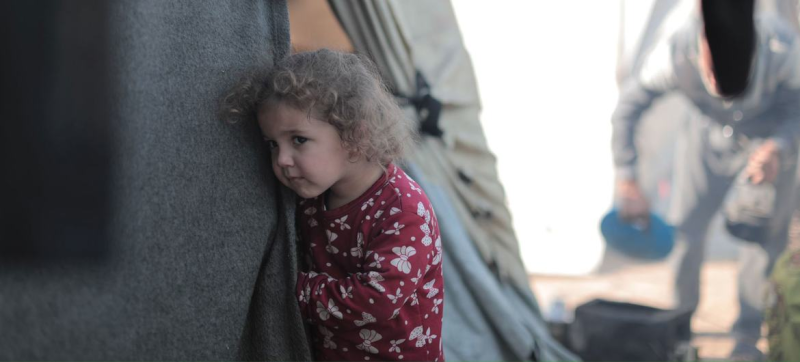- UN Estimates $70 Billion Needed to Rebuild Gaza After War |
- Mirpur garment factory, chemical godown fire kills 9 |
- Garbage pile turns Companiganj Bazar into an unhygienic town |
- Put 'old feuds' aside for a new era of harmony in ME: Trump |
- Rivers are Bangladesh's lifeblood, Rizwana at UN Water Convention |
UN Estimates $70 Billion Needed to Rebuild Gaza After War

A young girl peers out from a tent in Gaza.
Around $70 billion will be needed to reconstruct Gaza and make it safe after two years of war, UN development experts said on Tuesday, while aid agencies warned that far too little assistance is reaching desperate Palestinians.
At just 41 kilometres long and 2–5 kilometres wide, few parts of the Gaza Strip were left unscathed by constant Israeli bombardment before the latest ceasefire came into effect last Friday.
According to Jaco Cilliers, UN Development Programme (UNDP) Special Representative for the Palestinians, destruction across the enclave “is now in the region of 84 percent. In certain areas, like Gaza City, it’s even up to 92 percent.”
$20 Billion Needed Immediately
Speaking from Jerusalem, Mr. Cilliers highlighted the findings of the latest Interim Rapid Damage and Needs Assessment (IRDNA) by the UN, the European Union, and the World Bank, estimating total damage at $70 billion. To jumpstart reconstruction, some $20 billion will be required over the next three years alone.
The UNDP is operating in Gaza alongside humanitarian partners to provide immediate support to the enclave’s 2.1 million residents, including clean water, emergency employment, medical supplies, waste removal, and clearing rubble that may conceal unexploded ordnance or missing Palestinians.
“We’ve already removed about 81,000 tonnes of debris—around 3,100 truckloads,” Mr. Cilliers explained. “Most debris removal ensures access for humanitarian teams to provide critical aid, but it also helps hospitals and other social services.”
The UNDP official noted positive signals from potential donors, including Arab states, European nations, and the United States, which has pledged support for early recovery efforts.
Immediate Aid Still Essential
While reconstruction is vital for Gaza’s long-term future, UN agencies again called on Israeli authorities to open all access points into Gaza, following the release of the remaining 20 living Israeli hostages and Palestinian prisoners.
The ceasefire deal between Hamas and Israel was signed Monday in Sharm El-Sheikh by US President Donald Trump and the leaders of Egypt, Qatar, and Türkiye. UN Secretary-General António Guterres welcomed the release of all living hostages, two years after around 250 were taken during Hamas-led attacks on 7 October 2023.
Voices from Gaza
UNICEF aid worker Tess Ingram recounted the story of a family displaced five times by the conflict:
“I met Mustafa and Syeda and their children. They consider themselves lucky because, while Mustafa clears rubble from their home, at least they still have a home,” she said.
The family relies on occasional water trucks and faces daily uncertainty accessing medicine and basic food. “Families need everything right now. We need the hundreds of trucks a day that were promised,” Ms. Ingram added.
Hostage Remains and Ongoing Needs
The focus also shifted to the transfer of deceased hostages from Gaza, a process overseen by the International Committee of the Red Cross (ICRC). It remains unclear how many deceased hostages will be transferred.
Aid needs in Gaza remain enormous and fluid, with more than 300,000 Palestinians moving north to Gaza City since Friday as the ceasefire seemed to hold.
“The international community’s enthusiasm isn’t reflected on the ground. We are not getting enough aid,” said UNICEF spokesperson Ricardo Pires.
Israeli authorities have agreed to allow 190,000 tonnes of relief supplies into Gaza. UN agencies are scaling up operations, but far more aid is required, humanitarian agencies, including OCHA, emphasized.
Challenges in Aid Distribution
Aid teams continue to stress the importance of distributing lifesaving supplies closer to affected communities. Hundreds of Palestinians have been injured or killed at remote distribution points.
“Most actors, including the ICRC, could not organize sufficient aid distribution inside Gaza,” said Mr. Cardon. “Aid needs to reach the people directly, rather than people having to go to distant aid hubs.”

